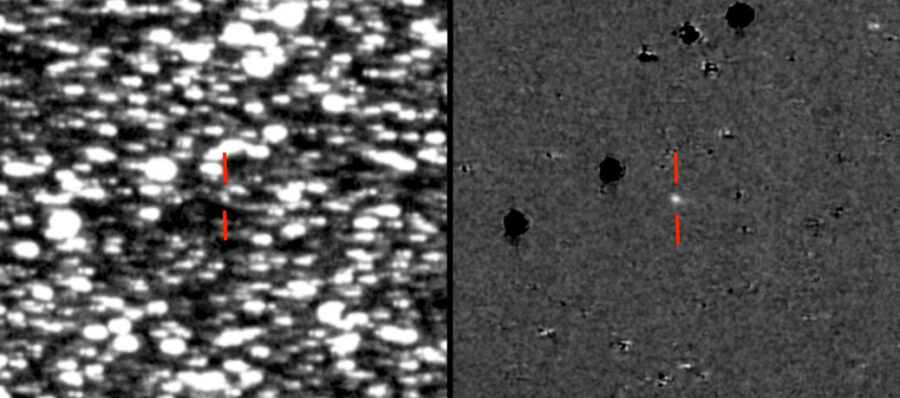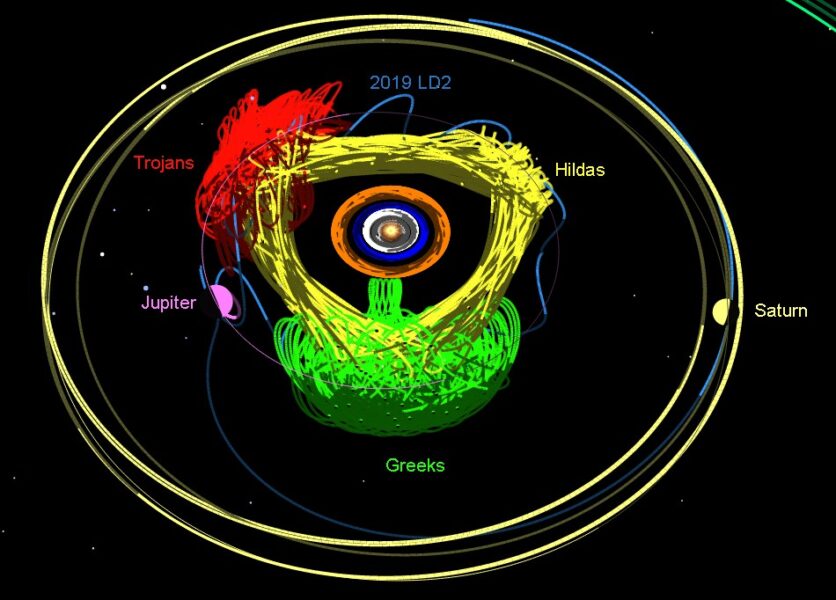Astronomers have discovered a comet trapped in a weird orbit near Jupiter.
Jupiter has captured an icy comet from the outer solar system in a bizarre orbit that will bring it back to within 3 million kilometers of the giant planet in 2063. The only Sun-orbiting objects known to come closer were the fragments of Comet Shoemaker-Levy 9, which plunged into the Jovian cloud deck in July 1994.

ATLAS / A. Heinze / IfA
A Centaur, Not a Trojan
A year ago, NASA's asteroid-hunting ATLAS project in Hawai'i discovered 2019 LD2, and further observations showed it was a comet. New observations this spring confirmed it as a periodic comet and placed its orbit near Jupiter, leading Larry Denneau (University of Hawaii) to announce May 20th that P/2019 LD2 was the first comet among the Trojans. This family of several thousand asteroids shares Jupiter's orbit but stays steady at about 60° ahead or behind of the planet. The discovery of a comet among Trojan asteroids was surprising because most of them are thought to have been captured in the solar system’s early years — any ices ought to have evaporated long ago.
However, when amateur astronomer Sam Deen used software on the Jet Propulsion Laboratory's solar-system dynamics website to calculate the object’s orbit, he found P/2019 LD2 recently had a close encounter with Jupiter that left its orbit unstable. The model showed that the comet had likely been a Centaur, part of a family of outer solar system asteroids, with an orbit reaching out to Saturn. Then, on February 17, 2017, it passed about 14 million kilometers from Jupiter, an encounter that sent the comet on a wild ride and inserted it into an odd Jupiter-like orbit.
Yet although the swing past Jupiter put P/2019 LD2 into a Jupiter-like orbit, it didn’t move it near to one of the two Lagrange points where the combination of gravitational forces from Jupiter and the Sun hold Trojan asteroids. Instead of being 60° — one-sixth of the giant planet's orbit — from Jupiter, P/2019 LD2 is only 21° ahead of Jupiter. The model predicts the comet will drift to no more than 30° ahead before the two begin converging again.
Future Passes
The comet will then pass within about 18 million km on May 13, 2028. That will alter the orbit again, Deen wrote on the Minor Planet Mailing List. That makes P/2019 LD2 a Jupiter-family comet — but not a Jupiter Trojan, as the Hawaii group now acknowledges. Project Pluto's Find_Orb model gives similar results to JPL’s model.
Another amateur, Tony Dunn, also found similar results. He illustrated the orbit using his own model to show the path of the object relative to Jupiter.

Courtesy Tony Dunn
The 2028 encounter will shift the comet from an orbit close to a 1:1 resonance with Jupiter to one near a 2:3 resonance. But that orbit won't last, because it will put P/2019 LD2 on course for a much closer planetary encounter.
"From Jupiter's perspective the comet will appear to slowly move around the Sun before coming back," Deen says. In January 2063, it will pass some 3 million kilometers from Jupiter, just outside the orbits of its Galilean satellites — close enough to cause a major redirection of the comet's orbit.
2063 and Beyond
Where P/2019 LD2 will go from there is unclear. The orbital uncertainties are large enough to make the results of that encounter difficult to predict, says Bill Gray of Project Pluto. "It could get tossed almost anywhere," he says, depending on how close it comes to Jupiter. The closer the encounter, the more dramatic the results could be.
Another wild card, Gray says, is that comets eject gas from various points on their surfaces, and it is very hard to model the impact of the resulting non-gravitational effects on their orbits. Such effects could enhance or diminish the effect of Jupiter’s gravitational force and could send it veering off in an unexpected direction. Strong forces can also fragment a comet, as happened to Shoemaker-Levy 9 before its impact.
The 2063 approach should yield new insight into a process that has helped shape the solar system: intense interactions between planetesimals and the gravitational giant of the solar system. The event should give us "a detailed look at the dynamics that convert Centaurs and long-period comets into short-period comets," says Deen. "Odds are that we'll have some spacecraft orbiting Jupiter by then that will be able to visit the interplanetary visitor up close." That would give a much better view of the action than we had for Shoemaker-Levy 9, when the collision itself happened on the side of Jupiter hidden from terrestrial observers and spacecraft.
 4
4









Comments
PGT
May 29, 2020 at 7:56 pm
Centaurs, Trojans, Greeks, and . . . Hildas?
You must be logged in to post a comment.
Joris
May 31, 2020 at 6:25 am
Yes, the Hildas aren't exactly part of Greek mythology, because that group is named after asteroid 153 Hilda. Astronomer Theodor von Oppolzer named the asteroid after one of his daughters.
You must be logged in to post a comment.
rocketMike
May 30, 2020 at 11:30 am
Uh-oh! Tony's beautiful simulation will surely lead to Jupiter's banishment from the league of planets when someone finds out how unclean-swept it's orbit is!
You must be logged in to post a comment.
Happylimpet
June 1, 2020 at 5:13 am
"Shoemaker-Levy 9, when the collision itself happened on the side of Jupiter hidden from terrestrial observers and spacecraft"....
dont forget Galileo had a direct view of the impacts while en route.
You must be logged in to post a comment.
You must be logged in to post a comment.